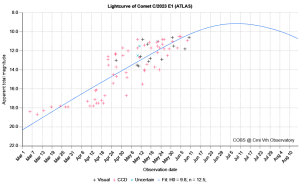2023 June 11
Comet of the month: C/2023 E1 (ATLAS)
There aren’t any bright comets around at the moment and the skies don’t really get dark at UK latitudes at this time of the year so this comet is a bit of a challenge.
C/2023 E1 (ATLAS) was discovered on 2023 March 1 as an apparently asteroidal object in Virgo. It was detected at magnitude 19 using the ATLAS 0.5-m, f/2 Schmidt at Sutherland, South Africa (CBET 5233). Prediscovery images were found all the way back to 2022 Dec 25.5 when the 2.25-m Bok reflector at Kitt Peak recorded it at magnitude 21.5. The calculated orbit strongly implied that it was a comet and its true nature was confirmed by several observers after the object was posted on the PCCP.
The latest astrometry shows that the comet is periodic with a period of 85 years and a perihelion distance, q, of 1.03 au. The comet comes to perihelion on July 1 when it will be 0.64 au from the Earth. It has been brightening faster than was expected at discovery and now looks as if it might reach 9th magnitude in early July. The comet will be closest to the Earth on August 18 but by then it will be fading rapidly as it moves away from the Sun.

The first image of the comet in our archive is from March 4th. This image from Guido and Valvasori shows the comet as an ateroidal object shortly after discovery. By the time that Peter Carson imaged it in late April it was showing a distinct coma. By May 15 I was able to pick it up as a fuzzy, green blob using a colour camera on a small refractor. By the end of May it was showing a coma around 3 arc minutes in diameter. The latest images are in the BAA archive here.
The comet is currently moving through Draco and it will pass near the pole in Ursa Minor around July 6 so it is very well placed for us in the northern hemisphere. Even though it may reach 9th magnitude it will be a challenging object visually since it is so diffuse. Photographers should be able to pick it up as a faint, green, fuzzy blob using a camera and telephoto lens. We should be able to follow it for the next few months. Please submit all of your observations to the section.

I hope to have more news on this comet at the section meeting in Greenwich on July 8. If you make any observations I’ll be able to show some of them at that meeting.
| The British Astronomical Association supports amateur astronomers around the UK and the rest of the world. Find out more about the BAA or join us. |
